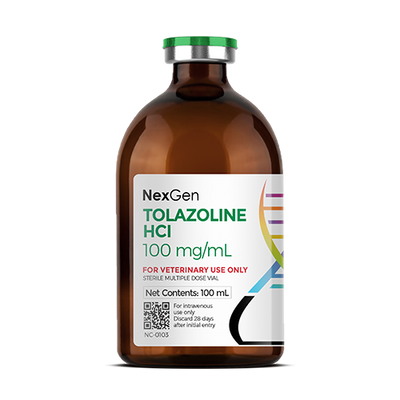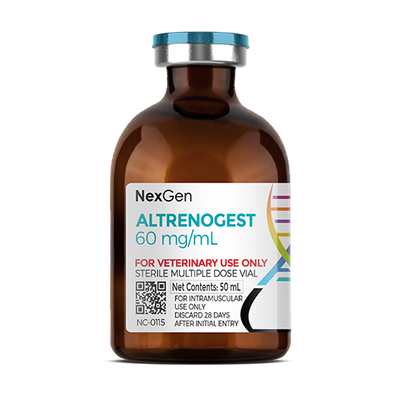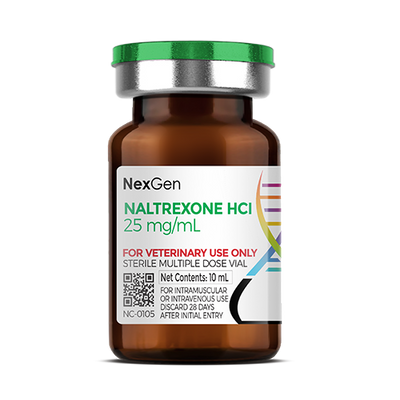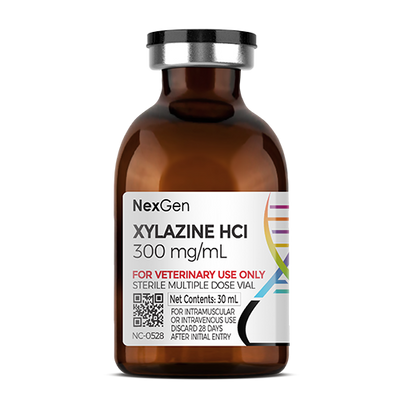
XylaMed Injection 100 mg/mL, 50mL
Login for pricing
- Brand
- VetOne
- SKU:
- RX-0065
- Product Type::
- Injectable
- Size::
- 50ml
- Administration::
- Intramuscular / Intravenous
VetOne Xylamed Injection: Sedative and Analgesic Solution for Veterinary Use
VetOne Xylamed Injection, a veterinary sedative and analgesic specifically designed for horses and Cervidae. This non-narcotic compound is FDA-approved, ensuring safety and efficacy for your animal patients.
Key Benefits:
- Effective Sedation: Ideal for managing aggressive or nervous animals, reducing stress and risk for both the animal and practitioner.
- Wide Range of Applications: Perfect for diagnostic, orthopedic, and dental procedures, as well as minor surgical operations of short duration.
- Pain Relief: Offers therapeutic relief following injury or surgery.
- Preanesthetic Qualities: Can be used as a preanesthetic to general anesthesia or alongside local anesthetics in major surgeries.
How It Works:
VetOne Xylamed Injection works by inhibiting the intraneural transmission of impulses in the central nervous system, providing sedative, analgesic, and muscle relaxant effects. Its rapid onset of action (10-15 minutes after intramuscular injection and 3-5 minutes following intravenous administration in horses) makes it a reliable choice for veterinary professionals.
Recommended Uses:
- For Horses: Includes handling, diagnostic procedures, orthopedic applications, dental procedures, minor surgeries, and as a calming agent for fractious animals.
- For Cervidae: Useful for handling, diagnostics, minor surgeries, and as a therapeutic medication for pain relief post-injury or surgery.
- Compatibility: Can be used with local anesthetics like procaine or lidocaine for enhanced efficacy.
Directions for Use: Xylamed Injection 100mg/mL, 50mL
Dosage and Administration:
Horses:
- Intravenously−0.5 mL/100 lbs body weight (0.5 mg/lb)
- Intramuscularly−1.0 mL/100 lbs body weight (1.0 mg/lb)
Cervidae
- Fallow Deer (Dama dama)−2.0 to 4.0 mL/100 lbs body weight (2.0 to 4.0 mg/lb).
- Mule Deer (Odocoileus hemionus)−1.0 to 2.0 mL/100 lbs body weight (1.0 to 2.0 mg/lb).
- Sika Deer (Cervus nippon)−1.0 to 2.0 mL/100 lbs body weight (1.0 to 2.0 mg/lb).
- White-Tailed Deer (Odocoileus virginianus)−1.0 to 2.0 mL/100 lbs body weight (1.0 to 2.0 mg/lb).
- Elk (Cervus canadensis)−0.25 to 0.5 mL/100 lbs body weight (0.25 to 0.5 mg/lb).
Following injection of XylaMed the animal should be allowed to rest quietly until the full effect has been reached.
These dosages produce sedation which is usually maintained for 1 to 2 hours and analgesia which lasts for 15 to 30 minutes.
Side Effects:
XylaMed, in horses and Cervidae, used at recommended dosage levels may occasionally cause slight muscle tremors, bradycardia with partial A-V heart block and a reduced respiratory rate. Movement in response to sharp auditory stimuli may be observed. In horses, sweating, rarely profuse, has been reported following administration. In Cervidae, salivation, various vocalizations (bellowing, bleating, groaning, grunting, snoring) on expiration, audible grinding of molar teeth, protruding tongue and elevated temperatures have also been noted in some cases.
Precautions:
Careful consideration should be given before administering to horses or Cervidae with significantly depressed respiration, severe pathologic heart disease, advanced liver or kidney disease, severe endotoxic or traumatic shock, or stress conditions such as extreme heat, cold, high altitude or fatigue.
Do not use XylaMed in conjunction with tranquilizers.
Analgesic effect is variable, and depth should be carefully assayed prior to surgical/clinical procedures. Variability of analgesia occurs most frequently at the distal extremities of horses and Cervidae.
In spite of sedation, the practitioner and handlers should proceed with caution since defense reactions may not be diminished.
Horses:
Since an additive effect results from the use of XylaMed and the barbiturate compounds, it should be used with caution with these central nervous system depressants. Products known to produce respiratory depression or apnea, such as thiamylal sodium, should be given at a reduced dosage and, when injected intravenously, should be administered slowly. When intravenous administration is desired, avoid perivascular injection in order to achieve the desired effect. Studies have shown negligible evidence of tissue irritation, however, following perivascular injection of xylazine.
Intracarotid Arterial Injection Should Be Avoided. As with many compounds, including tranquilizers, immediate violent seizures followed by collapse may result from inadvertent administration into the carotid artery.
Although the reaction with XylaMed is usually transient and recovery may be rapid and complete, special care should be taken to assure that the needle is in the jugular vein rather than the carotid artery. Bradycardia and arrhythmia in the form of incomplete atrioventricular block have been reported following xylazine administration. Although clinically the importance of this effect is questioned,1,2,3,4 a standard dose of atropine given prior to or following xylazine will greatly decrease the incidence.
Sedation for transport is most successful if actual transportation is begun after the full effect of the drug has been reached and the animal’s stability is maintained while standing. In addition, it should be noted that animals under the influence of XylaMed can be aroused by noise or other stimuli and this may increase the risk of injury.
Cervidae:
As in all ruminants, it is preferable to administer XylaMed to fasted Cervidae as a safeguard against aspiration of food material into the lungs and/or bloat during deep sedation. Care should be taken to administer XylaMed in the heavy muscles of the croup or shoulder. Injections given subcutaneously, intraperitoneally or into fat deposits will give unpredictable results.
Intra-arterial injection should be avoided. As with many compounds, including tranquilizers, immediate violent seizures followed by collapse may result from inadvertent administration into an artery.
The animal should not be disturbed during induction or until the full effect of the drug has been reached, which is usually 10 to 15 minutes following injection.
The usual time to initial effect of the drug is 2 to 5 minutes. The administrator of the drug should be fully cognizant of this interval prior to administration of drug to free-ranging deer or elk, especially at night or in heavily wooded areas.
If the animal has been underdosed (faulty injection or miscalculation of weight) it is advisable to wait one hour before administering a second dose.
Adequate ventilation, especially in cages or crates, is mandatory; keep head and neck in position to insure patent air passage and to prevent aspiration of stomach contents.
During sedation animals should be prevented from assuming lateral recumbency. A sternal recumbent position is desirable.
While under the effects of XylaMed the animal should be protected from an extremely hot or cold environment.
Efforts should be made to prevent patient from rising until almost complete recovery is attained.
The transportation of Cervidae given XylaMed should be carefully monitored to prevent excessive struggling, injury, or death.
Hyperthermic reactions may occur, especially if the subject is in a highly excited state when the drug is administered. Hosing the head and entire body with cold water has usually proven to be an effective deterrent.
The safety of XylaMed has not been demonstrated in pregnant Cervidae. Avoid use during the breeding season.
Cervidae should be observed closely until all of the sedative effects of XylaMed are gone.
Care should be taken at all times when administering XylaMed to Cervidae. This is due to the method of administration (usually darting), the difficulty in estimating body weights and the accepted theory that wild animals are more unpredictable in their response to sedatives and analgesics than the domesticated species.
Safety:
XylaMed is tolerated at 10 times the recommended dose in horses, and at doses above the recommended range in Cervidae. However, some elevated doses produced muscle tremors and long periods of sedation.
Warning:
This drug should not be administered to domestic food-producing animals. Not for use in horses intended for food.
Avoid accidental administration to humans. Should such exposure occur, notify a physician immediately. Artificial respiration may be indicated.
In Cervidae, occasional capture-associated deaths occur. Clinical trials reveal a mortality rate of approximately 3.5% attendant with the administration of xylazine.
Storage:
Store at 20ÀöC - 25ÀöC (68ÀöF - 77ÀöF). Do not freeze.
FOR RX ONLY: A valid prescription from a licensed veterinarian is required for dispensing this medication.



















